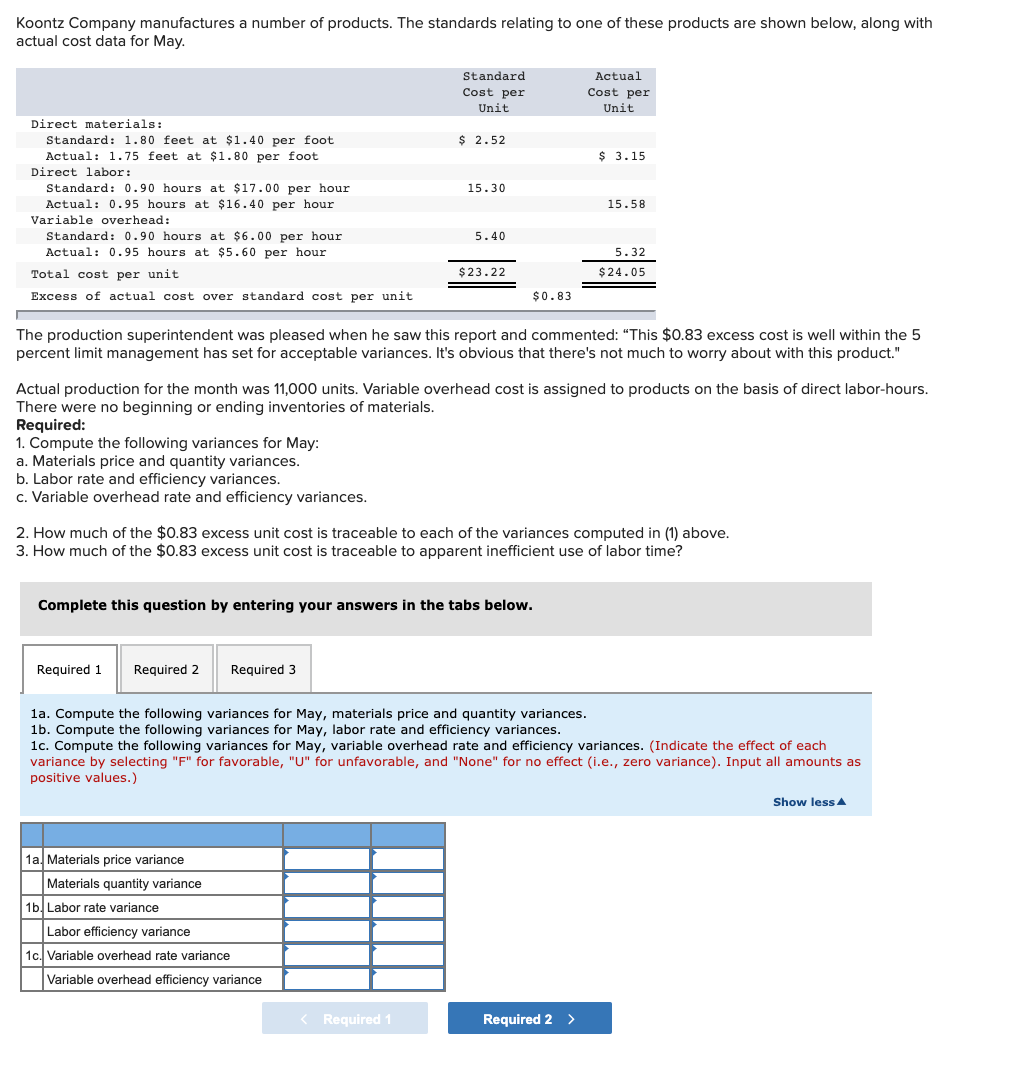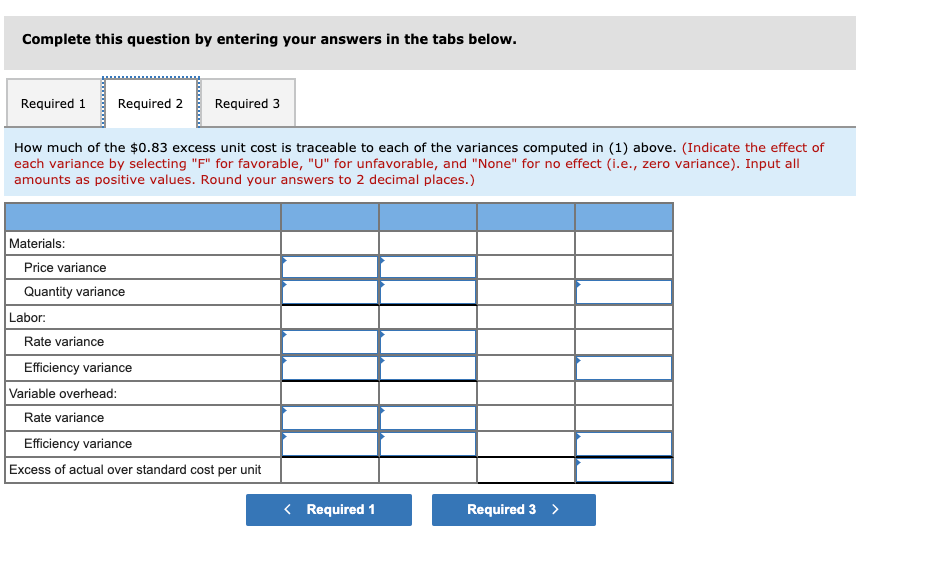Koontz Company manufactures a number of products. The standards relating to one of these products are shown below, along with actual cost data for May. Standard Actual Cost per Cost per Unit Unit Direct materials: $ 2.52 Standard: 1.80 feet at $1.40 per foot Actual: 1.75 feet at $1.80 per foot $ 3.15 Direct labor: Standard: 0.90 hours at $17.00 per hour Actual: 0.95 hours at $16.40 per hour Variable overhead: 15.30 15.58 Standard: 0.90 hours at $6.00 per hour Actual: 0.95 hours at $5.60 per hour 5.40 5.32 Total cost per unit $23.22 $24.05 Excess of actual cost over standard cost per unit $0.83 The production superintendent was pleased when he saw this report and commented: "This $0.83 excess cost is well within the 5 percent limit management has set for acceptable variances. It's obvious that there's not much to worry about with this product." Actual production for the month was 11,000 units. Variable overhead cost is assigned to products on the basis of direct labor-hours. There were no beginning or ending inventories of materials. Required: 1. Compute the following variances for May: a. Materials price and quantity variances. b. Labor rate and efficiency variances. c. Variable overhead rate and efficiency variances. 2. How much of the $0.83 excess unit cost is traceable to each of the variances computed in (1) above. 3. How much of the $0.83 excess unit cost is traceable to apparent inefficient use of labor time? Complete this question by entering your answers in the tabs below. Required 1 Required 2 Required 3 la. Compute the following variances for May, materials price and quantity variances. 1b. Compute the following variances for May, labor rate and efficiency variances. 1c. Compute the following variances for May, variable overhead rate and efficiency variances. (Indicate the effect of each variance by selecting "F" for favorable, "U" for unfavorable, and "None" for no effect (i.e., zero variance). Input all amounts as positive values.) Show less A 1a. Materials price variance Materials quantity variance 1b. Labor rate variance Labor efficiency variance 1c. Variable overhead rate variance Variable overhead efficiency variance < Required 1 Required 2
Koontz Company manufactures a number of products. The standards relating to one of these products are shown below, along with actual cost data for May. Standard Actual Cost per Cost per Unit Unit Direct materials: $ 2.52 Standard: 1.80 feet at $1.40 per foot Actual: 1.75 feet at $1.80 per foot $ 3.15 Direct labor: Standard: 0.90 hours at $17.00 per hour Actual: 0.95 hours at $16.40 per hour Variable overhead: 15.30 15.58 Standard: 0.90 hours at $6.00 per hour Actual: 0.95 hours at $5.60 per hour 5.40 5.32 Total cost per unit $23.22 $24.05 Excess of actual cost over standard cost per unit $0.83 The production superintendent was pleased when he saw this report and commented: "This $0.83 excess cost is well within the 5 percent limit management has set for acceptable variances. It's obvious that there's not much to worry about with this product." Actual production for the month was 11,000 units. Variable overhead cost is assigned to products on the basis of direct labor-hours. There were no beginning or ending inventories of materials. Required: 1. Compute the following variances for May: a. Materials price and quantity variances. b. Labor rate and efficiency variances. c. Variable overhead rate and efficiency variances. 2. How much of the $0.83 excess unit cost is traceable to each of the variances computed in (1) above. 3. How much of the $0.83 excess unit cost is traceable to apparent inefficient use of labor time? Complete this question by entering your answers in the tabs below. Required 1 Required 2 Required 3 la. Compute the following variances for May, materials price and quantity variances. 1b. Compute the following variances for May, labor rate and efficiency variances. 1c. Compute the following variances for May, variable overhead rate and efficiency variances. (Indicate the effect of each variance by selecting "F" for favorable, "U" for unfavorable, and "None" for no effect (i.e., zero variance). Input all amounts as positive values.) Show less A 1a. Materials price variance Materials quantity variance 1b. Labor rate variance Labor efficiency variance 1c. Variable overhead rate variance Variable overhead efficiency variance < Required 1 Required 2
Cornerstones of Cost Management (Cornerstones Series)
4th Edition
ISBN:9781305970663
Author:Don R. Hansen, Maryanne M. Mowen
Publisher:Don R. Hansen, Maryanne M. Mowen
Chapter9: Standard Costing: A Functional-based Control Approach
Section: Chapter Questions
Problem 32P: Petrillo Company produces engine parts for large motors. The company uses a standard cost system for...
Related questions
Concept explainers
Question
Having trouble!

Transcribed Image Text:Koontz Company manufactures a number of products. The standards relating to one of these products are shown below, along with
actual cost data for May.
Standard
Actual
Cost per
Cost per
Unit
Unit
Direct materials:
Standard: 1.80 feet at $1.40 per foot
$ 2.52
Actual: 1.75 feet at $1.80 per foot
$ 3.15
Direct labor:
Standard:0.90 hours at $17.00 per hour
Actual: 0.95 hours at $16.40 per hour
15.30
15.58
Variable overhead:
Standard: 0.90 hours at $6.00 per hour
Actual: 0.95 hours at $5.60 per hour
5.40
5.32
Total cost per unit
$23.22
$24.05
Excess of actual cost over standard cost per unit
$0.83
The production superintendent was pleased when he saw this report and commented: "This $0.83 excess cost is well within the 5
percent limit management has set for acceptable variances. It's obvious that there's not much to worry about with this product."
Actual production for the month was 11,000 units. Variable overhead cost is assigned to products on the basis of direct labor-hours.
There were no beginning or ending inventories of materials.
Required:
1. Compute the following variances for May:
a. Materials price and quantity variances.
b. Labor rate and efficiency variances.
c. Variable overhead rate and efficiency variances.
2. How much of the $0.83 excess unit cost is traceable to each of the variances computed in (1) above.
3. How much of the $0.83 excess unit cost is traceable to apparent inefficient use of labor time?
Complete this question by entering your answers in the tabs below.
Required 1
Required 2
Required 3
la. Compute the following variances for May, materials price and quantity variances.
1b. Compute the following variances for May, labor rate and efficiency variances.
1c. Compute the following variances for May, variable overhead rate and efficiency variances. (Indicate the effect of each
variance by selecting "F" for favorable, "U" for unfavorable, and "None" for no effect (i.e., zero variance). Input all amounts as
positive values.)
Show less A
1a. Materials price variance
Materials quantity variance
1b. Labor rate variance
Labor efficiency variance
1c. Variable overhead rate variance
Variable overhead efficiency variance
< Required 1
Required 2 >

Transcribed Image Text:Complete this question by entering your answers in the tabs below.
Required 1
Required 2
Required 3
How much of the $0.83 excess unit cost is traceable to each of the variances computed in (1) above. (Indicate the effect of
each variance by selecting "F" for favorable, "U" for unfavorable, and "None" for no effect (i.e., zero variance). Input all
amounts as positive values. Round your answers to 2 decimal places.)
Materials:
Price variance
Quantity variance
Labor:
Rate variance
Efficiency variance
Variable overhead:
Rate variance
Efficiency variance
Excess of actual over standard cost per unit
< Required 1
Required 3 >
Expert Solution
This question has been solved!
Explore an expertly crafted, step-by-step solution for a thorough understanding of key concepts.
This is a popular solution!
Trending now
This is a popular solution!
Step by step
Solved in 4 steps

Knowledge Booster
Learn more about
Need a deep-dive on the concept behind this application? Look no further. Learn more about this topic, accounting and related others by exploring similar questions and additional content below.Recommended textbooks for you

Cornerstones of Cost Management (Cornerstones Ser…
Accounting
ISBN:
9781305970663
Author:
Don R. Hansen, Maryanne M. Mowen
Publisher:
Cengage Learning

Principles of Accounting Volume 2
Accounting
ISBN:
9781947172609
Author:
OpenStax
Publisher:
OpenStax College

Managerial Accounting: The Cornerstone of Busines…
Accounting
ISBN:
9781337115773
Author:
Maryanne M. Mowen, Don R. Hansen, Dan L. Heitger
Publisher:
Cengage Learning

Cornerstones of Cost Management (Cornerstones Ser…
Accounting
ISBN:
9781305970663
Author:
Don R. Hansen, Maryanne M. Mowen
Publisher:
Cengage Learning

Principles of Accounting Volume 2
Accounting
ISBN:
9781947172609
Author:
OpenStax
Publisher:
OpenStax College

Managerial Accounting: The Cornerstone of Busines…
Accounting
ISBN:
9781337115773
Author:
Maryanne M. Mowen, Don R. Hansen, Dan L. Heitger
Publisher:
Cengage Learning

Principles of Cost Accounting
Accounting
ISBN:
9781305087408
Author:
Edward J. Vanderbeck, Maria R. Mitchell
Publisher:
Cengage Learning